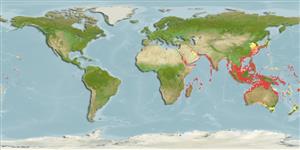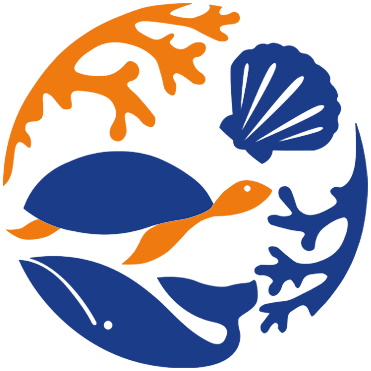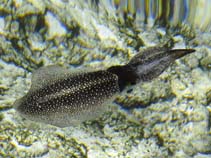Sepioteuthis lessoniana Férussac, 1831
Bigfin reef squid| Native range | All suitable habitat | Point map | Year 2050 |

|
| This map was computer-generated and has not yet been reviewed. |
| Sepioteuthis lessoniana AquaMaps Data sources: GBIF OBIS |
Classification / Names Tên thường gặp | Các synonym ( Các tên trùng) | CoL | ITIS | WoRMS
Cephalopoda | Myopsida | Loliginidae
Environment: milieu / climate zone / Mức độ sâu / distribution range Sinh thái học
gần đáy; Thuộc về nước lợ; Mức độ sâu 0 - 100 m (Tài liệu tham khảo 275). Tropical; 51°N - 48°S, 22°E - 155°W (Tài liệu tham khảo 106950)
Distribution Các nước | Các khu vực của FAO | Các hệ sinh thái | Những lần xuất hiện | Những chỉ dẫn
Indo-Pacific: from Japan to Australia and New Zealand coasts, from Hawaii to the East African coast, north to Red Sea and south to Madagascar. Introduced in the Mediterranean Sea.
Length at first maturity / Bộ gần gũi / Weight / Age
Chín muồi sinh dục: Lm ? range ? - ? cm Max length : 40.1 cm ML con đực/không giới tính; (Tài liệu tham khảo 121859); Khối lượng cực đại được công bố: 1.80 g (Tài liệu tham khảo 275)
Life cycle and mating behavior Chín muồi sinh dục | Sự tái sinh sản | Đẻ trứng | Eggs | Sự sinh sản | Larvae
Main reference
Các tài liệu tham khảo | Người điều phối | Người cộng tác
Roper, C.F.E., M.J. Sweeney and C.E. Nauen 1984 FAO Species Catalogue. Vol. 3. Cephalopods of the world. An annotated and illustrated catalogue of species of interest to fisheries. FAO Fish. Synop. 125(3):277p. Rome: FAO. (Tài liệu tham khảo 275)
IUCN Red List Status
(Tài liệu tham khảo 130435: Version 2025-1)
CITES status (Tài liệu tham khảo 108899)
CMS (Tài liệu tham khảo 116361)
Threat to humans
Human uses
Các nghề cá: Tính thương mại
FAO - Các nghề cá: landings | FishSource | Biển chung quanh ta
Các công cụ
Thêm thông tin
Max. ages / sizes
Length-weight rel.
Length-length rel.
Length-frequencies
Mass conversion
Sự phong phú
Các nguồn internet
BHL | BOLD Systems | CISTI | DiscoverLife | FAO(Các nghề cá: ; publication : search) | Fishipedia | GenBank (genome, nucleotide) | GloBI | Gomexsi | Google Books | Google Scholar | Google | PubMed | Cây Đời sống | Wikipedia (Go, tìm) | Tạp chí Zoological Record



